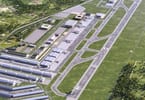SAS Scandinavian Airlines has been for long an advocate of sustainable development in relation to the environment. A position that reflects Scandinavia society’s general relation to nature. The airline remains one of the most innovative in the world to look at reducing the impact of its activities on the environment and can be used as a benchmark for other carriers. Martin Porsgaard Nielsen, “SAS Mr. Environment” gives to eTurboNews reader an inside vision of SAS commitment.
In which fields is SAS involved to contribute to reduce the environmental impact of its air transport activities?
Martin Porsgaard Nielsen: They are four instruments to achieve sustainable development: we can influence directly on the first two which are operational measures and technology development; we have a say on the third one which is infrastructure and must work out with economic measures, mostly taxes.
Is the rise in fuel prices the best incentive to act by reducing aircraft’s consumption?
Nielsen: If I tell that fuel consumption represents more than 95 percent of all environment impact, the public will understand that rocketing prices pushes up to act quickly to reduce our costs. Reducing costs means to look at solution to burn as little as possible fuel. We are first streamlining our network by cutting on less profitable flights, combining together frequencies on high-density routes and grounding some 11 aircraft. We are increasingly suffering from overcapacity as fuel is becoming more expensive. Since 2005, we started a program with the goal to reduce fuel consumption by 6 percent to 7 percent by 2011. We should already reach 3 percent by the end of 2008. They are many ways to reduce fuel consumption: optimizing the weight of the aircraft, reducing the aircraft speed, modernizing our fleet with aircraft having a low consumption or changing also our flight procedures. Long-term goal of our industry is to reduce carbon dioxide (CO²) consumption per passengers by 50 percent in 2020 with an average growth of our activity by 4 percent…
You are talking about changing flight procedures. How efficient are your green landing procedures?
Nielsen: We generally cooperate with national air traffic control authorities to look at practices to fly best. SAS is for example the first airline in Europe to introduce green approach, a procedure conducted in cooperation with the Swedish Civil Aviation [Luftfartsverket]. Green approach is for the moment done at Stockholm Arlanda airport with Boeing 737 and Airbus A340 on the Chicago route. It involved some 2,500 landing since its beginning at the end of 2006. It is a complicate procedure, which requests perfect training from air traffic controllers as they must already track aircraft 42 minutes before landing. Air traffic controllers and pilots must then communicate to find the shortest way to land with consequently the lowest possible emissions. On average, such a landing saves around 150 kg of fuel or 450 kg of CO² emissions. Gothenburg airport is introducing green approach this year. We are now talking to Copenhagen airport as well as to the Norway Civil Aviation to look at possible implementation there.
What about the savings by reducing speed? Does it not put passengers at disadvantage as they are losing time in the air?
Nielsen: Savings by reducing speed by 60 to 70 km are estimated to save between 250 and 300 kg of fuel per flight. We experiment flights at reduced speed on the Oslo-Bergen route. It does translate for the passengers into three minutes more in flying time compared to the previous timetable. I believe that it is perfectly bearable to the passengers.
Are you also looking at alternative fuel sources?
Nielsen: We have been supporting Swedish scientists in cooperation with Volvo Aero and the Swedish Government to work on developing a new aircraft fuel mixing traditional petroleum with renewable raw materials. I must emphasize that we only want to use biomass which are not food crops such as algae. This is what we call biofuel of the second or third generation. Such a new fuel generation could help us to cut CO² emissions by 15 percent to 20 percent.
Making infrastructure more efficient is basically reorganizing air traffic control management. How far do you succeed to change things?
Nielsen: A streamlined air traffic control management with a single European Sky would translate into fuel savings of 10 percent to 15 percent with similar results in carbon emission reductions. We work already work very closely with ATC in Scandinavian and Baltic countries to create a Nordic Single Sky. Cooperation already started between civil aviation authorities in Denmark and Sweden with very favorable results.
Some airport authorities in Scandinavia complaint that your ageing medium-haul fleet is a source of increased pollution. What do you reply to this?
Nielsen: It is true that our MD80 and some of our Boeing 737 come from previous generation, despite the fact that they are very economical aircraft. However, SAS fleet is already composed at 75 percent of new generation air planes. Regarding the 25 percent remaining, we do not have any plan yet to change them right away. We will make an announcement on our short- and medium-haul fleet renewal within 3 years time. We face a dilemma: should we change our aircraft progressively with immediate benefit of noise reduction and fuel savings of 10 percent to 15 percent or should we wait for the next generation of aircraft? Manufacturers such as Airbus and Boeing estimate that a brand new generation of plane would save up to 30 percent on fuel consumption. Such a plane would however not be ready before 2016. In the meantime, we further improve the efficiency of our aircraft. We just added winglets to 20 aircraft which bring fuel savings of 2 percent to 3 percent.
SAS is one of the few airlines supporting an Emission Trading System in Europe. Why?
Nielsen: We find that it is a fair way to implement airlines into a carbon compensation scheme as it will help to reduce effectively emissions. We think that this system is fairer than the various national taxes and charges which burden the airline industry today without proving any kind of efficiency for their goal. The designed emissions trading scheme will be acceptable if it does not restrict airlines to continue to grow.
WHAT TO TAKE AWAY FROM THIS ARTICLE:
- The airline remains one of the most innovative in the world to look at reducing the impact of its activities on the environment and can be used as a benchmark for other carriers.
- SAS is for example the first airline in Europe to introduce green approach, a procedure conducted in cooperation with the Swedish Civil Aviation [Luftfartsverket].
- We have been supporting Swedish scientists in cooperation with Volvo Aero and the Swedish Government to work on developing a new aircraft fuel mixing traditional petroleum with renewable raw materials.






















